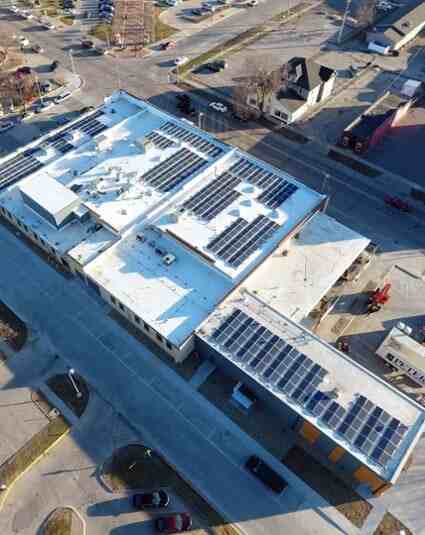Thinking about solar for your business? One of the first questions that comes up is: How much will it cost?
While there’s no one-size-fits-all answer because every system is different, here we outline the primary factors that can significantly influence the investment cost for a commercial solar system .
The 4 largest cost drivers of any commercial solar project
1. System Size
 In the solar industry, system size is typically measured by DC capacity—which directly correlates with how much electricity the system will produce. A common cost metric is $/kWdc (dollars per kilowatt DC), reflecting the capital investment relative to system size—similar to how architects reference $/sq.ft.
In the solar industry, system size is typically measured by DC capacity—which directly correlates with how much electricity the system will produce. A common cost metric is $/kWdc (dollars per kilowatt DC), reflecting the capital investment relative to system size—similar to how architects reference $/sq.ft.
One of the most appealing aspects of solar is its scalability. Systems can be designed to fit virtually any budget. Smaller installations can start modestly and be expanded over time, while larger systems benefit from economies of scale, often resulting in a lower cost per kilowatt installed. Despite the price difference, both large and small systems can yield excellent payback—especially for facilities with higher utility rates.
At SunPeak, we begin every project by analyzing current energy usage and available space to determine the optimal system size for a strong return on investment (ROI). Oversizing can lead to diminished returns, so accurate sizing based on a full energy analysis is essential.
2. Mounting Style
 Solar installations fall into two main categories: rooftop and ground-mount. Rooftop systems are installed on flat or pitched roofs and integrate with the building’s existing structure. Ground-mounted systems are built on open land and require the construction of dedicated support structures anchored directly into the ground, which requires more materials, equipment, and planning. While the fixed costs are greater, ground-mounted systems can often be built bigger than rooftop systems, therefore they have the potential to become more cost effective when a very large system is desired.
Solar installations fall into two main categories: rooftop and ground-mount. Rooftop systems are installed on flat or pitched roofs and integrate with the building’s existing structure. Ground-mounted systems are built on open land and require the construction of dedicated support structures anchored directly into the ground, which requires more materials, equipment, and planning. While the fixed costs are greater, ground-mounted systems can often be built bigger than rooftop systems, therefore they have the potential to become more cost effective when a very large system is desired.
Generally speaking, for a commercial solar PV system below 5 MWdc, a rooftop installation will likely be less expensive than a ground-mounted system of the same size.
A third option, solar carports, is a type of ground-mount built over parking areas. Solar carports are typically more costly due to the structural work needed to withstand wind loads. As a result, they’re most attractive in areas with high electricity rates and strong incentives. Many carport customers also find added value in the shade and protection carports provide.
3. Electrical Infrastructure Considerations
 Another variable to estimating solar system costs is whether facility upgrades will be needed to interconnect the system. Older buildings sometimes require updates to their AC infrastructure to support solar, which can add to the overall project cost.
Another variable to estimating solar system costs is whether facility upgrades will be needed to interconnect the system. Older buildings sometimes require updates to their AC infrastructure to support solar, which can add to the overall project cost.
System size relative to the existing electrical setup also plays a role. There are often strategic “steps” in system sizing, where staying just below certain thresholds can result in the most cost-effective solution, thus maximizing value while avoiding expensive infrastructure changes.
While utility-related upgrades are needed in a minority of projects, they can significantly impact costs and timelines when required.
Before any project moves forward, SunPeak conducts a thorough site inspection and reviews electrical schematics to assess potential upgrade needs. In many cases, no upgrades are required at all, making for a straightforward and highly cost-effective installation.
4. Seismic Considerations
 Lastly, for solar systems installed in earthquake-prone regions, an extra layer of structural evaluation is typically required, along with additional anchoring to meet seismic safety standards.
Lastly, for solar systems installed in earthquake-prone regions, an extra layer of structural evaluation is typically required, along with additional anchoring to meet seismic safety standards.
While these measures are straightforward to implement, they can add to project costs compared to installations in areas with lower seismic risk.
Evaluating Solar Cost Considerations for Your Business
Several key factors can influence the cost of a commercial solar project, among the most important are system size, mounting method, the condition of the facility’s electrical infrastructure, and any seismic requirements based on location.
While these general considerations provide a helpful starting point, the best way to understand what’s right for your business is to connect with a qualified solar provider. Every project is unique, and the final design typically emerges through an iterative process that balances technical requirements, goals, and budget.
At SunPeak, our industry-leading expertise and customer-first approach make us a trusted long-term energy partner. Our proven process and experienced team make going solar straightforward and stress-free, helping companies easily cut energy costs and lead with sustainability.
We’d love to guide your business through the process. Ready to get started? Request your free solar analysis today.
